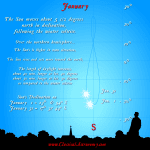Category: The Sun at Noon
THE SUMMER SOLSTICE
THE SUMMER SOLSTICE: Today is the first day of summer for the northern hemisphere, the longest day of the year. On this day, the Sun reaches it’s maximum northern declination of the year. Thus, this day is the winter solstice for the southern hemisphere, the shortest day of the year for the lands south of the equator. For a detailed… Continue reading
The Analemma of the Sun

[slideshow_deploy id=’95’] Continue reading
Noon Sun During May
During May, the days grow long much less than in April, since the Sun increases only 7 degrees in declination, compared to 14-1/2 degrees in that previous month. (Compare with the previous month’s graphics.) The length of daylight only increases between 23 to 54 minutes for most locations in the USA, whereas daylight increased nearly two hours in April.… Continue reading
During April, the days grow significantly longer since the equinox (the first day of spring). The Sun rises earlier and sets later, and is now quite high in the sky at noon. As a result, by month’s end, the length of daylight is almost two hours longer than at the beginning of spring. Note in the figure that, by… Continue reading
Noon on the Vernal Equinox
The vernal equinox is March 20. Spring begins for the northern hemisphere at the precise moment when the Sun is centered on the celestial equator, zero degrees in declination, the midpoint between the north and south celestial poles. Every location in the world will experience 12 hours of daylight and 12 hours of nighttime…. except the North and South… Continue reading
Noon During March
During March, the days grow significantly longer. The Sun rises earlier and sets later, and is now quite high in the sky at noon. As a result, by month’s end, the length of daylight is three hours longer than on the shortest day, back in December. Continue reading
Noon During February
The days have grown noticeably longer through February. The Sun increases 9 degrees in declination over month, a total of 15 degrees since the winter solstice, and the noon Sun is higher in the sky by that amount. As a result, by month’s end, the length of daylight is two hours longer than on the shortest day, with sunrise… Continue reading
Noon During January
The days begin to get longer in January as the Sun increases in declination, rising higher in the noon sky and having a more northerly amplitude at sunrise and sunset. Continue reading
Noon on the Winter Solstice
The winter solstice is this Sunday. What does that mean, exactly? It means several things, actually. Continue reading
